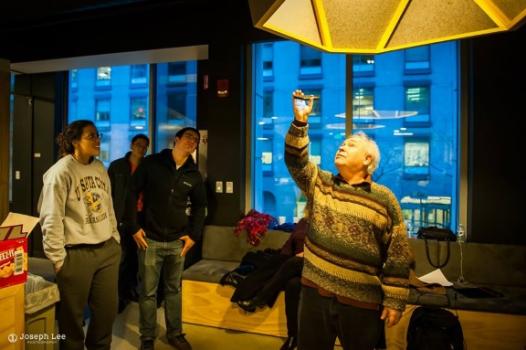Boop Light Detector App
Boop is an an app developed for iOS users (8.0 and above) to detect levels of light and interpret this information with sound. It allows its blind and visually impaired users to detect whether lights are on or off. It covers a broad range of light levels which span from sensing daylight through open windows to checking whether the indicator light is on for a wifi router.
Boop does not require any additional hardware and has been tested on a variety of different phones (4s-6s) in addition to iPads.
Download Boop on the Itunes store using this direct link or search for "Boop Light Detector" in the Itunes app.

Features
There are other light detectors on the app store, but we argue Boop is the best for the following reasons:
- Boop is free
- Boop provides a larger range of light detection by using more than simple pixel values from the camera. We also factor in the camera exposure and sensitivity levels, leading to a robust light detection that's insensitive to varying lighting conditions or high contrast and provides higher resolution than its competitors.
- Boop is fast and responsive. Our app consists of one single screen and uses an asynchronous system to simultaneous track light levels and send quick, audible feedback.
- Boop was developed with the accessibility voice over features in mind. We make use of the gestures and have the familiar magic touch (or two finger double tap) to exit the app.
- Last, and possibly most importantly, we have a vibrate feature for using the app in quiet areas. Based on the frequency of vibrations, you can estimate light intensity and source location.
How to use Boop
Screen Overview
The following are 4 screenshots taken while using Boop. The app is structured as follows: display of video capture on top, reading of luminescence in the middle, and a toggle vibrate button at the bottom. All items are centered in the screen and easy to access.
This app can help you determine where a light source is located. To help achieve this directional sensing, only the light level at the center of the video screen (directly perpendicular to the phone face) is measured. In the 3rd and 4th screenshot, the ceiling lamp is within the capture view. However, the 4th screenshot has the lamp centered and has a much higher luminescence reading (which goes from 0 - 100) .
Starting the App
Use the default iOS navigation to open Boop. When Boop starts you will feel a sequence of 3 vibration pulses to let you know it is running.
The first time using the app, you will need to give it permission to access your camera. If you don't do this then the app will display an error at the bottom of the screen. Manually go into your settings and enable Boop's access to your camera.
Closing the App
The app shuts down whenever you exit out of it to preserve your phone's memory and battery life. To exit the app hit the home key. Voice Over users: In addition to using the home key to shutdown the app, you can use the "magic tap" or two finger double tap to exit.
Vibrate On or Off
The main feature you can change in the app is vibrate on or off. To do this, toggle the button at the bottom-center of the screen. Voice Over users: In addition to toggling the vibrate switch, you can use the "Two-finger scrub" as well on any part of the screen. This is the Z-shaped gesture, also called an Escape, performed with two fingers.
Volume Control
The volume can be controlled by the volume keys at the side of the phone . You can make the overall volume higher or lower. Additionally, the mute switch will shut off any sound coming from Boop. This can be used with the vibration on to sense light levels in quiet areas such as a library or near a sleeping partner.
Hearing the Light Level Reading
Voice over users can simply tap the center of the screen where the luminescent reading is labeled. Then, voice over will read to you the value of the light reading, which ranges from 0 - 100.
Safety and Privacy
Boop requests camera access to determine the amount of light in the center of the camera's image. It computes the luminescent score and does not save any images.
Boop does not have any questionable content- it only displays two types of messages:
- luminescent reading
- error message since boop does not have access to the camera
Boop does not store any metadata or other user generated content. Boop does not have advertisements.
Boop is FREE
Boop is free and will continue to be free. If you would like to support us, leave a positive review for our application. Additionally, we encourage donations to VIBUG.org and Perkins School for the blind.
News
The MIT Assistive Technology Hackathon (ATHack) was in the news: http://www.ll.mit.edu/news/students-build-assistive-technologies-for-Boston-residents-in-need.html
We received honorable mention at ATHack: http://assistivetech.mit.edu/athack/2016.html
Authors and Contributors
Boop is developed, maintained, and released by Ariel Anders. The first version of our app was created while participating in the MIT Assistive Technology Hackathon 2016 with teammates Daniel Preston and Areej Al-Wabil. Preston assisted with user testing and app refinement following the hackathon and developing the first app released to the Apple app store. Since our initial release of the app in July 2016, no new features has been added; however, each year the app the is updated to compy with Apple's app standards.
The idea for our app was presented by Jonathan Gale, a blind avid iPhone user. Jonathan wanted to use his phone to determine if lights were on in his home to save energy. Jonathan helped with all aspects of our development including rigorous testing during and after ATHack.
Support or Contact
Feel free to shoot us a message at anders.ariel@gmail.com